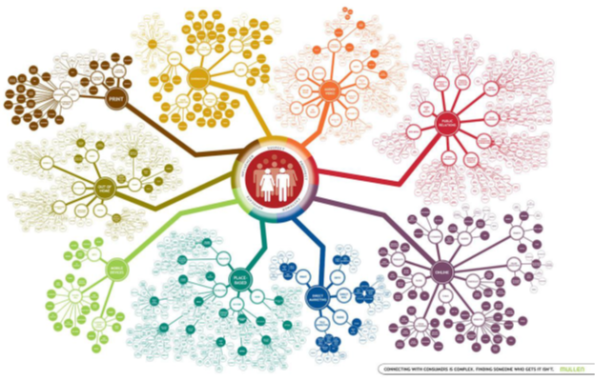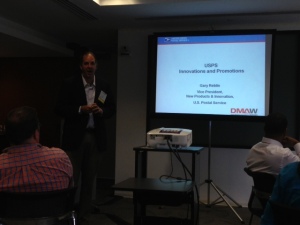Archive
Mobile First Mentality and Testing will move your Organization Forward in Digital Marketing
by Danielle Hart
At DMAW’s Digital Day, keynote Greg Kihlstom hit the nail on the head when he opened his presentation by describing how the world is growing more digital, mobile and segmented by niche markets. So what does that mean for the future of the Direct Marketing industry?
Now more than ever, customers and donors are expecting more local, personalized, and immediate interactions with brands and organizations. And they are expecting these experiences to be seamless. Whether the focus is on brand awareness or taking action, digital marketing interactions and digital fundraising efforts are building direct relationships with customers and donors.
In order to acquire and cultivate customers or donors, brands and organizations will have to build direct relationships. In order to build these relationships with customers or donors, in an age where everyone has a mobile phone or tablet, how will brands and organizations move forward with new marketing channels and evolving technology?
1. Putting the mobile mentality first
With consistent growth in mobile and tablet device usage, it’s imperative for brands and organizations to approach future campaigns from the mobile and experiential point of view, above all others. As Amy Gonzalez from Blueprint Interactive pointed out in her presentation “Beyond a Single Screen,” depending on whom your brand or organization is trying to reach and what you’re trying to do, it’s important to study the pros and cons of different mobile strategies before getting started.
For your brand or organization’s website, there are a few options to consider when making it mobile friendly. These options include using a mobile website redirect, designing a responsive website, or creating a mobile application. Every organization has different needs and will have to determine which strategy will be most appropriate and effective for their organization and audience.
- Mobile Website Redirect – This website technique puts a redirect for all mobile website traffic to a separate mobile website (m.website.com or mobile.website.com). The unique mobile website allows you to completely redesign a website specifically for mobile devices. Don’t want a homepage photo slideshow to play for mobile users? Do want an uncomplicated website for web visitors on a mobile phone? The mobile redirect might be the answer for you. When using this technique, it is important to look into past website traffic analytics and consider traffic trends in your design, menus, and key website functionalities.
- Responsive Design – Want one version of your website to look great across all devices? If your website needs to be consistent across multiple devices, a responsive website is the way to go. Responsive design allows a website to respond to the device viewing it and adjust itself accordingly to fit the screen. This technique optimizes search engine rankings since it is the same content across all browsers and is usually quicker to load. Responsive design also makes website updates easier since everything is in one place.
- Mobile App – What’s better than an awesome app that connects with your audience? If your organization wants to engage “super-users” or “super-donors” and you can add value for your audience with a mobile app, then this is the right choice. Keep in mind that there are many extra steps in creating a mobile app — including creating multiple versions for different types of phones, deciding on pricing (paid or free with possible paid advertising/in-app purchases), writing the literature for download agreements, planning for updates, and getting approved by the Apple/Android store. Before jumping into creating an app, make sure you’ve spent quality time researching your audience and whether or not they’d use the app. And remember, a person will have to download this app, so there needs to be be an attractive reason for your audience to download it.
Now that your mobile-friendly website options are on the table, the next topic up for debate is mobile-friendly email. As Dan Caro, from Whereoware explained in his presentation “Making Your Emails Mobile Friendly,” the choices for mobile-friendly email are responsive design or using a mobile optimized, scalable template.
- Responsive Email – A responsive email has multiple versions of certain pieces of code within one template. The CSS media queries trigger the different versions of code to render differently depending on the device being used to read the email. And while responsive design is better for a mobile and tablet heavy audience, it does require more technical resources and is more expensive. For large organizations that have a mobile-heavy audience, responsive design is the way to go.
- Mobile-Optimized Email – A mobile optimized email is one version of code that’s scalable and renders well regardless of the device being used to read it. This includes buttons that are at least 44x44px, minimal text, and a clear CTA. For smaller organizations that don’t have the technical resources and budget, or the mobile heavy audience to justify a responsive design email, a mobile optimized email is the best option.
2. Never stop testing
Sure, your brand or organization might have found what seems like the be all end all best practice! But with technology changing constantly, what works one day, might be irrelevant the next. So how do you keep up? How do you evaluate what new trends and technologies can help your cause or brand? One word – testing.
As Sean Powell from The Engage Group and Heather Marsh from ABD Direct described in their presentation “Testing Mayhem – Sustainer Pop Ups + New Responsive Design + Hitting your Budget = WTF?!?!” there are many tests that organizations can run to work towards better results for your cause or brand.
What are some example tests to try in an email campaign?
- Ascending vs. descending ask strings
- Dynamic vs. static ask strings
- Open text box vs. no open text box ask string
- Short vs. long copy
- Square vs. horizontal imagery
- Imagery vs. no imagery
- Very little copy with large image vs. more copy with small CTA
- Text vs. graphic CTA
- Security seal vs. no security seal
But it doesn’t stop there. While A/B testing your control emails will give you insight on how to increase engagement and response rates within an email campaign, there are even more ideas and techniques to test. For example, testing imagery vs. inline forms for a website pop-up, testing mobile versions of forms with less vs. more fields, or maybe even testing different donation form intercept algorithms, are just some more examples of website testing your brand or organization may want to try. Just keep in mind that for a useful test, it’s important to only change one variable from the control in order to be confident that the results are coming from that specific variable.
Moving forward you want to consider your brand or organization’s mobile friendliness, and continue to test everything. Great, that’s enough to make any organization’s head spin! So now what?
While it’s important for brands and organizations to understand the importance of these practices, it’s also very important to know what you don’t know. And as Greg Kihlstrom noted, with the industry becoming more data driven, real-time, predictive, and semantic, more agencies will have an increased need for specialization. Your brand or organization may not be able to specialize in every new marketing channel, data analytics platform, or technical advancement, so building relationships with agencies that are specialized will help your brand or organization stick to the core of your business or cause.
_________________________________________________________________________
 Danielle Hart doubles as an Online Fundraising Account Manager at The Engage Group and a Postal Logistics Account Manager at MailSmart Logistics. Danielle can be reached at Danielle@engageyourcause.com.
Danielle Hart doubles as an Online Fundraising Account Manager at The Engage Group and a Postal Logistics Account Manager at MailSmart Logistics. Danielle can be reached at Danielle@engageyourcause.com.
Are Your Emails “Good Enough” For Mobile?
By Jennifer Newell, Digital Services Manager, Production Solutions/PS Digital
Last week I attended the DMAW’s Digital Day Forum and came away with a lot of great takeaways. But one of the sessions that stood out to me most was Making Your Emails Mobile Friendly, presented by Dan Caro, Director, Online Marketing Operations at Whereoware.
Did you know that 1/3 of marketers don’t know what percentage of prospects access their emails via mobile?
I know I was surprised by that figure, but what’s the big deal? Why should we care?
Caro provided some astounding statistics that really made us sit up and listen:
A Litmus report showed that 47% of email opens are on a mobile device. This is a new record for mobile, increasing 24% since 2012.
And the number of mobile users is continuing to grow. Caro cited Forrester’s study which estimates that 78% of emails will be opened via mobile device by 2017. That’s four short years from now!
Furthermore, Constant Contact found that 75% of people surveyed said they are likely to delete an email if they can’t read it on a smartphone.
So in four years, if over ¾ of emails are opened via mobile device and ¾ of THOSE people are deleting your non-mobile friendly email, that’s a whole lot of people missing your message.
Ok, I get it, mobile’s a big deal. We should be ready though, we’ve been taking care of this, right?
According to Marketing Sherpa’s 2013 Email Mktg Benchmark Survey, 58% of marketers are NOT designing their emails to render differently on mobile devices. REALLY?!
In Dan Caro’s words “This is not good enough.” With the variety of devices and screen sizes people are using today, we must be mindful of how our emails will render on each device. And I have to agree.
But never fear! Mobile might be a big deal, but getting started isn’t. Caro breaks it down with easy to follow steps that can get you on the right track sooner rather than later.
First, know your options.
Don’t have the time and resources? Scalable design might be for you: a one-size-fits-all solution where only one version of the email is created to render well on all devices.
Are your email openers primarily mobile users? Do you have a responsive web site? It might be worth it for you to go with responsive design. Multiple versions of the email are created and CSS media queries are used to adjust email size automatically based on the device it is opened on.
Make your message readable and touch friendly.
Whichever type of design you go with; there are a few specifications that all mobile friendly designs should include:
- Larger font size – 14-16pt preferred
- Skinnier email design – 320 x 550px wide (it’s best to go with a single column when possible)
- Touch friendly CTA – 44 x 44px
Make sure your message is streamlined.
It is still important to ensure that your message is cohesive from start to finish, from the subject line, to preview text, to email body, to landing page. It must all work together. We are marketers after all!
Don’t forget to quality control.
Multiple designs + multiple platforms could equal multiple errors. Make sure you’ve tested your email across several platforms before deployment.
Where do you go from here?
It’s never too late to get started! Begin by understanding how many of your subscribers are reading your emails on a mobile device, and testing your current email templates on a variety of phones and tablets.
Once you know where you are, you can make a plan to get where you need to go. Be sure to share your progress with your friends at the DMAW!
_________________________________________________________________________
 Jennifer Newell has been with Production Solutions since 2006 in production management, process improvement and most recently as a manager in Production Solutions’ PS Digital division.
Jennifer Newell has been with Production Solutions since 2006 in production management, process improvement and most recently as a manager in Production Solutions’ PS Digital division.
Let’s Geek Out Over Data!
by Gay Bitter
I am a self-professed data geek, so Angela Struebing’s presentation on Multichannel Attribution at the August DMAW Lunch and Learn was right up my alley. Calculators were not provided but there was plenty of math during this great presentation!
So, what is multichannel attribution and why does it matter? This methodology provides a new tool to the campaign analysis process that allows you to more effectively give credit to the correct communications channel and touch point in a multichannel campaign. When used correctly, it enhances the ability to maximize marketing dollars spent.
This colorful infographic, The Mullen Marketing Ecosystem, is a somewhat overwhelming example of all of the communications channels potentially influencing your donors or customers.

Prospects don’t see a single message, so how do you figure out how to use your organization’s marketing dollars wisely? Each channel has its own metrics, each brings in donors or customers with varying lifetime values, and each has its own rate of response decay. Using attribution allows you to measure lift by channel and will help you determine which channels to continue to use and which to drop.
Current practices that many marketers use are Confirmed Response and Matchbacks. Flaws in these analysis tools are that they don’t factor in organic joins, follow-ups are likely given undue credit, and only touches with a reply device can be measured. Another practice, Fractional Allocation, is used in many iterations, but again, doesn’t provide true insight on the contribution that each marketing channel makes to a donation or response.
Using weighted multichannel attribution (yes, some math is required here!) gets you closer to seeing the value of each channel. Angela shared an example measuring the effectiveness of mail, email, telemarketing and cookie ads on a campaign. Using this method, she found that cookie ads were using 9% of the marketing budget, but contributed only 1% to donations, so this channel should be dropped. Mail used 66% of the budget and contributed 52% to contributions, so reducing mail quantity is a logical step. Telemarketing, which used 20% of the budget but contributed 33% to donations, should be increased.
So what are the pitfalls? You need to withhold prospects during testing. This gives you a baseline to measure against. That means you are missing potential donors; you can correct this by increasing your prospect universe on your next campaign. The good news? You only need to test once a year, and results for clients in similar industries can be used for others in the same industry, but be aware that results can differ based on geography as well as industry.
Here are a few best practices to consider before you engage in multichannel attribution for your organization.
- Make sure your offer and creative is consistent across channels – use the same imagery and message.
- Online interactions should be held to two clicks or engagement will drop.
- Contact prospects many times until you see diminishing returns or increased opt-outs.
- Plan your analytics and coding before you start.
Attribution is not a magic bullet that replaces all of your tried and true marketing analysis, so don’t throw out your old results. It’s just another tool in your toolbox. And, one last bit of advice from Angela, don’t get caught up in analysis paralysis. Know when to stop!
_________________________________________________________________________
 Gay Bitter is Vice President, Marketing at Relevate, a leading provider of comprehensive data marketing solutions. She can be reached at gbitter@relevategroup.com.
Gay Bitter is Vice President, Marketing at Relevate, a leading provider of comprehensive data marketing solutions. She can be reached at gbitter@relevategroup.com.
Christmas in July? Not Quite, but Close…
by Heather Marsh
It may only be August, but if you haven’t yet started planning for the year-end giving season, now’s the time! You may think you have plenty of time to put together your year-end campaigns, but before you know it, we’ll all be bundled up, eating turkey and missing the warm weather. Don’t get caught scrambling later — here are a few tips to help you get started:
Test Your Controls
In the next couple of months, you should focus on testing into the very best creative for year-end. Part of this process entails retesting all of your controls. Take the time to reevaluate campaign elements such as:
- From Line
- Email Signer
- Ask Strings
- Timing – Day of the Week or Hour of the Day
Make a Plan (and Plan to Change It)
Spend some time now planning your holiday schedule. Make sure you factor in a mix of email communications — this is prime giving season, but it’s also important to thank your donors and advocates for all the support they’ve already given this year. Review last year’s plan and results, plan to roll out with the big successes and continue the testing you worked on last year.
By planning ahead now, you’ll be prepared for those last-minute challenges that always come up. Give yourself as much flexibility within the plan as you can. You never know when a news event, such as last year’s terrible Sandy Hook tragedy on December 14, will require an adjustment to your schedule.
Get Started Now
Now that you’ve made your plan, get started right away! Plan your creative brainstorming sessions. Get your technical specifications and gather your troops. Evaluate your strategy to determine what’s realistic with your current resources, and arrange for extra support if needed.
Live Test Your Program
We’ve all had times when the brilliantly designed campaign strategy doesn’t quite translate to real-life success. Perhaps your welcome series needs some updates. Or it could be that your audience segmentation (or suppression) isn’t capturing everyone you intended it to. Literally put yourself in your donor’s shoes — walk their path to make sure all the systems are working as intended.
Bring It All Together
The good news is that your direct mail counterparts are bound to be thinking about year-end well in advance! Planning for your online campaign isn’t enough; you need to think about the complete donor experience. Spend some time reviewing the makeup of your donor file. How many receive both emails and direct mail? Will you have telefundraising campaigns running at the same time? Consider the overall message, making sure your donors will get a clear, consistent message. Don’t forget to look at your data processes as well. Make sure you can include or exclude donors in as close to real-time as possible.
Other elements to consider now: Are your forms mobile and responsively designed? Have you updated your Google AdWords accounts to account for the new enhanced campaigns? (Speaking of that — don’t forget to renew your Google Grant accounts!)
Whatever you’re planning, get started now!
_________________________________________________________________________
 Heather is Director of Digital Marketing for ABD Direct, a division of AB Data, Ltd. She has 10 years of direct marketing experience, and has worked with clients such as Wounded Warrior Project, Mothers Against Drunk Driving, The Wilderness Society, Disabled American Veterans, and many others. She feels strongly that it is time to take a holistic approach to marketing – bringing digital, mail and other channels together to maximize communication with donors. She can be reached at heather.marsh@abdata.com
Heather is Director of Digital Marketing for ABD Direct, a division of AB Data, Ltd. She has 10 years of direct marketing experience, and has worked with clients such as Wounded Warrior Project, Mothers Against Drunk Driving, The Wilderness Society, Disabled American Veterans, and many others. She feels strongly that it is time to take a holistic approach to marketing – bringing digital, mail and other channels together to maximize communication with donors. She can be reached at heather.marsh@abdata.com
Mail is not dead, but we must innovate and diversify to stay relevant!
USPS New Products and Innovations Executive Enlightens DMAW Lunch and Learn Attendees about Increasing the Long-term Value of Mail by Leveraging New Technology
 At the June 20 DMAW Lunch and Learn, Gary Reblin, the United States Postal Service’s Vice President of New Products and Innovations, strongly advised that organizations need to be innovative in order to stay relevant amidst the bombardment of information in this day and age.
At the June 20 DMAW Lunch and Learn, Gary Reblin, the United States Postal Service’s Vice President of New Products and Innovations, strongly advised that organizations need to be innovative in order to stay relevant amidst the bombardment of information in this day and age.
According to the 2012 Mail Moment Survey, 80% of people surveyed look at their mail as a valuable news source, 75% like to see what’s in the mail and 63% of mail is kept at least two days. Amongst the youth, 79% sort the mail at the first opportunity, 72% would like to receive more personal mail and 67% scan the mail looking for important/interesting mail. All statistics that prove mail is still highly valuable, across all age groups.
As a marketing tool, mail is still considered to be extremely beneficial. With mail, you are able to have more targeted advertising to your customers or donor base, it can be a cost-effective platform, mail offers an interactive solution through the use of integrated technology and success and effectiveness of each campaign is easily measured.
In order to stay relevant, organizations must recognize that an online and offline, integrated marketing approach will yield optimum results – the USPS recognizes this and has made a push to encourage mailers to utilize technology within their campaigns. By promoting mail innovations, the USPS is helping organizations enhance their mailpiece thus improving consumer engagement and increasing response rate, customer acquisition and Return on Investment (ROI).
Recent studies show that PC shipments are down and mobile commerce is on the rise with 81% increased sales in 2012, to nearly $25 billion according to eMarketer (Jan 2013). Mail and mobile is an optimum connection as the mailpiece provides a ‘jumping-off point,’ but the mailer must ensure a positive consumer experience by offering a mobile coupon and/or offer, mobile-optimized website and a responsive website that dynamically adapts both its content and layout to fit a multi-screen world (Smartphone, tablet or PC).
Although they are not yet final or approved, Gary was able to share some of the USPS Promotions and Incentives on the horizon for 2014:
- Branded/Customized Mobile Technology
- Mail Drives Mobile Commerce
- Personalization
- Mobile Application
- Colorization of Bills and Statements
- Premium Advertising Product
- Emerging Technology
- Earned Value Reply Mail
Through promotions and incentives and by continuing to highlight new technology and best practices, encourage and accelerate industry innovation and increase relevancy and engagement with consumers, the Postal Service’s objective is to increase the long-term value of mail.
During the wrap-up and question and answer session of Gary’s presentation, the hottest topic was the application process. It was clear that those in the room representing the Nonprofit sector of our industry had concerns with the amount of time and energy it took to get approved, and that some of the promotions and/or incentives didn’t apply to their organization, or the ones they represent, based on certain requirements. Gary and his team at the USPS are fully aware of the industry’s concerns and they are working to address them. There are four things that will help this; preparedness and earlier launch of the programs, longer promotional windows, variability in the promotion option and timing and added flexibility for customers.
A special thanks to James “J.R.” Caine and the team at Pitney Bowes Presort Services for sponsoring the June Lunch and Learn. And don’t forget, the DMAW has a great line-up of events headed your way:
- July EdVent – Thursday, July 18, 6 pm: The Contextual Marketing Revolution – presented by Geoff Livingston, Author and Marketing Specialist, Lady Soleil, Inc.
- MAXI Awards Ceremony – Wednesday, July 31, 2013, 4:30-6:30 pm
- August Lunch and Learn – Thursday, August 15: Multi-channel Attribution for Non-profits – presented by Angela Struebing, Agency Director, CDR Fundraising Group
_________________________________________________________________________
 Amie Sharaf is a Senior Account Manager, cross-training as a Client Services Manager, with Production Solutions where she has worked since September 2009. She can be reached at asharaf@psmail.com.
Amie Sharaf is a Senior Account Manager, cross-training as a Client Services Manager, with Production Solutions where she has worked since September 2009. She can be reached at asharaf@psmail.com.

